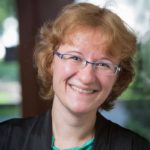Please join us this Friday, April 7th at 3 pm. in Collins 318 for our seventh Faculty Colloquium of this semester. Treats will be provided and please note the change in location.
Presenter: Michaela Kleinert, Associate Professor of Physics
Title: “Danger! Do not look into the laser beam with your remaining eye!” – Or – What is going on in Kleinert’s research lab?
Since its invention in 1960, the laser has become an integral part of our society. While most everyday lasers are cw (continuous wave) lasers of low power – for example barcode scanners at the grocery checkout –, powerful pulsed lasers that produce extremely short bursts of light (between only a billionth and a millionth of a billionth of a second long!) find more specialized applications both in research and industry. From the creation of super-hydrophobic surfaces that are completely water-repellent to the formation of micrometer sized structures that guide light or allow computers to work properly, from identifying explosives at long range to determining the chemical composition of ancient coins or even rocks on Mars – if you can imagine it, there is a laser to do the job!

A generous donation of two 10-ps pulsed laser systems (ESI, Beaverton) has allowed me to enter this fascinating field of research, and in this talk I will discuss projects that are currently being investigated in my research lab. I will introduce the physics of laser/material interaction that leads to the formation of microstructures on metallic surfaces. I will also talk about the plasma plume, the ejected material that forms above the surface and that can be a blessing and a curse: A dense plume leads to strong recombination lines as the electrons recombine with their respective ions. This is advantageous when investigating laser-induced breakdown spectroscopy (LIBS) since it amplifies the characteristic chemical fingerprints that allow us to identify unknown samples. On the other hand, a large plasma plume also acts as a shield and prevents the laser light from hitting the surface (plasma shielding). This of course is not desired when the goal is to pattern the surface in a controlled way (micromachining).
Students are welcome. We look forward to seeing you there.
Doreen Simonsen and Daniel Rouslin
Faculty Colloquium Coordinators
